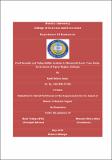| dc.description.abstract | Food insecurity in Ethiopia is a serious problem facing humanity. Households face recurrent food
shortages most of which threaten their livelihoods and impact negatively on their Welfare. Empirical
findings have shown that access to sufficient food is unstable. Suggesting that whether a household
or individual is food secure at any point in time is best thought of in a dynamic sense. In this paper
an analysis of vulnerability is conducted to find out which groups of households are more likely to
be food insecure and to remain food insecure in the near future and to identify the influencing
factors of vulnerability to food insecurity. Given the lack of panel data in the study area for an ideal
vulnerability assessment, the methodology of Capaldo, Karfakis, Knowles and Smulders, (2010)
developed for a cross sectional data is adopted. The study comprehensively looks the food security
status at household level through different descriptive and econometric tools such as GLS,and logit
model. Using a sample data of 2444 rural households from the 2011 Tigray Rural Base Line Socio
Economic Survey (TRBSS) the study revealed that access to adequate food in the study area is
unstable, only 48.07% of households enjoy stable levels of food security. In contrast, 28.77 percent of the
sampled households were found in transitory situation moving in to and out of food insecurity and
23.16% of the population is undernourished (food insecure) while also being vulnerable; these are considered
chronically food insecure. Implying that, food security interventions and policies based on static
analysis miss significant proportion of the population in the study area. This work also identified
who are vulnerable (some of the characteristics of households with higher vulnerability to food
insecurity) and its influencing factors. Hence, it will help better planning interventions to improve
the food security status in general and particularly of the study area.
Key words: vulnerability, food insecurity, rural Tigray. | en_GB |


